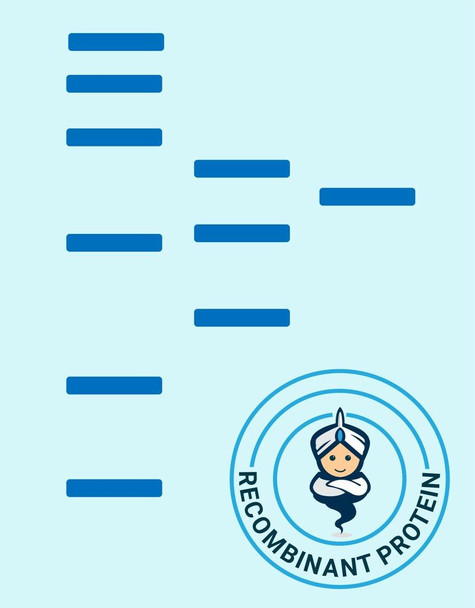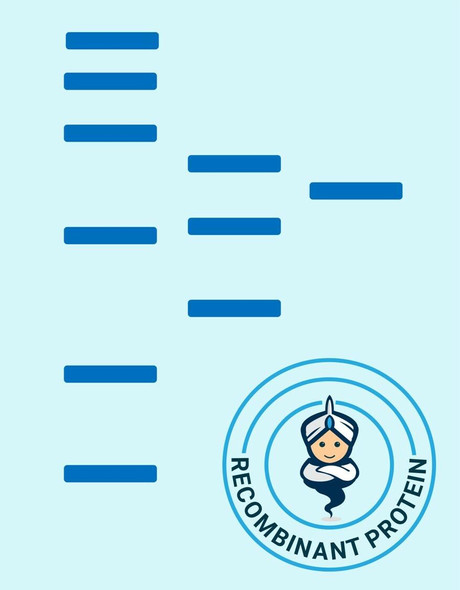Human PLA2G2D Recombinant Protein (RPPB2122)
- SKU:
- RPPB2122
- Product type:
- Recombinant Protein
- Size:
- 10ug
- Species:
- Human
- Target:
- PLA2G2D
- Synonyms:
- Group IID secretory phospholipase A2
- EC 3114
- Phosphatidylcholine 2-acylhydrolase GIID
- GIID sPLA2
- Source:
- Escherichia Coli
- Uniprot:
- Q9UNK4
Description
| Product Name: | Human PLA2G2D Recombinant Protein |
| Product Code: | RPPB2122 |
| Size: | 10µg |
| Species: | Human |
| Target: | PLA2G2D |
| Synonyms: | Group IID secretory phospholipase A2, EC 3.1.1.4, Phosphatidylcholine 2-acylhydrolase GIID, GIID sPLA2, PLA2IID, sPLA(2)-IID, Secretory-type PLA, stroma-associated homolog, SPLASH, sPLA2S, PLA2G2D. |
| Source: | Escherichia Coli |
| Physical Appearance: | Sterile Filtered lyophilized (freeze-dried) powder. |
| Formulation: | Sterile filtered and lyophilized from 0.5 mg/ml in 0.05M Acetate buffer pH-4. |
| Solubility: | Add 0.2 ml of 0.1M Acetate buffer pH-4 and let the lyophilized pellet dissolve completely. For conversion into higher pH value, we recommend intensive dilution by relevant buffer to a concentration of 10 ?g/ml. In higher concentrations the solubility of this antigen is limited. |
| Stability: | Store lyophilized protein at -20°C. Aliquot the product after reconstitution to avoid repeated freezing/thawing cycles. Reconstituted protein can be stored at 4°C for a limited period of time; it does not show any change after two weeks at 4°C. |
| Amino Acid Sequence: | MRGSHHHHHHGMASHMGILNLNKMVKQVTGKMPILSYWPYGCHCGLGGR GQPKDATDWCCQTHDCCYDHLKTQGCGIYKYYRYNFSQGNIHCSDKGSWC EQQLCACDKEVAFCLKRNLDTYQKRLRFYWRPHCRGQTPGC |
Phospholipase A2 (PLA2) catalyzes the hydrolysis of the sn-2 position of membrane glycerophospholipids to liberate arachidonic acid (AA), a precursor of eicosanoids including prostaglandins and leukotrienes. The same reaction also produces lysophosholipids, which represent another class of lipid mediators.The secretory PLA2 (sPLA2) family, in which 10 isozymes have been identified, consists of low molecular weight, Ca2+-requiring secretory enzymes that have been implicated in a number of biological processes, such as modification of eicosanoid generation, inflammation, and host defense.This enzyme has been proposed to hydrolyze phosphatidylcholine (PC) in lipoproteins to liberate lyso- PC and free fatty acids in the arterial wall, thereby facilitating the accumulation of bioactive lipids and modified lipoproteins in atherosclerotic foci.In mice, sPLA2 expression significantly influences HDL particle size and composition and demonstrate that an induction of sPLA2 is required for the decrease in plasma HDL cholesterol in response to inflammatory stimuli. Instillation of bacteria into the bronchi was associated with surfactant degradation and a decrease in large: small ratio of surfactant aggregates in rats.
Secreted Phospholipase A2-IID Human Recombinant was produced with N-terminal His-Tag. PLA2G2D His-Tagged Fusion protein is 16.4 kDa containing 125 amino acid residues of the human secreted phospholipase A2-IID and 16 additional amino acid residues – His-Tag (underlined).
| UniProt Protein Function: | PLA2G2D: PA2 catalyzes the calcium-dependent hydrolysis of the 2- acyl groups in 3-sn-phosphoglycerides. L-alpha-1-palmitoyl-2- linoleoyl phosphatidylethanolamine is more efficiently hydrolyzed than the other phospholipids examined. Belongs to the phospholipase A2 family. |
| UniProt Protein Details: | Protein type:Lipid Metabolism - alpha-linolenic acid; Lipid Metabolism - linoleic acid; Lipid Metabolism - ether lipid; Phospholipase; Lipid Metabolism - arachidonic acid; Secreted; Secreted, signal peptide; Lipid Metabolism - glycerophospholipid; EC 3.1.1.4 Chromosomal Location of Human Ortholog: 1p36.12 Cellular Component: extracellular region Molecular Function:phospholipase A2 activity; calcium ion binding Biological Process: phospholipid metabolic process; glycerophospholipid biosynthetic process; phosphatidic acid biosynthetic process; inflammatory response; lipid catabolic process |
| NCBI Summary: | This gene encodes a secreted member of the phospholipase A2 family, and is found in a cluster of related family members on chromosome 1. Phospholipase A2 family members hydrolyze the sn-2 fatty acid ester bond of glycerophospholipids to produce lysophospholipids and free fatty acid. This gene may be involved in inflammation and immune response, and in weight loss associated with chronic obstructive pulmonary disease. Alternative splicing results in multiple transcript variants encoding different isoforms. [provided by RefSeq, Nov 2012] |
| UniProt Code: | Q9UNK4 |
| NCBI GenInfo Identifier: | 20139286 |
| NCBI Gene ID: | 26279 |
| NCBI Accession: | Q9UNK4.2 |
| UniProt Secondary Accession: | Q9UNK4,Q9UK01, A8K2Z1, B1AEL9, |
| UniProt Related Accession: | Q9UNK4 |
| Molecular Weight: | 145 |
| NCBI Full Name: | Group IID secretory phospholipase A2 |
| NCBI Synonym Full Names: | phospholipase A2, group IID |
| NCBI Official Symbol: | PLA2G2D |
| NCBI Official Synonym Symbols: | SPLASH; sPLA2S; PLA2IID; sPLA2-IID |
| NCBI Protein Information: | group IID secretory phospholipase A2; GIID sPLA2; secretory phospholipase A2s; phosphatidylcholine 2-acylhydrolase 2D; secretory-type PLA, stroma-associated homolog |
| UniProt Protein Name: | Group IID secretory phospholipase A2 |
| UniProt Synonym Protein Names: | PLA2IID; Phosphatidylcholine 2-acylhydrolase 2D; Secretory-type PLA, stroma-associated homolog |
| Protein Family: | Group IID secretory phospholipase |
| UniProt Gene Name: | PLA2G2D |
| UniProt Entry Name: | PA2GD_HUMAN |










